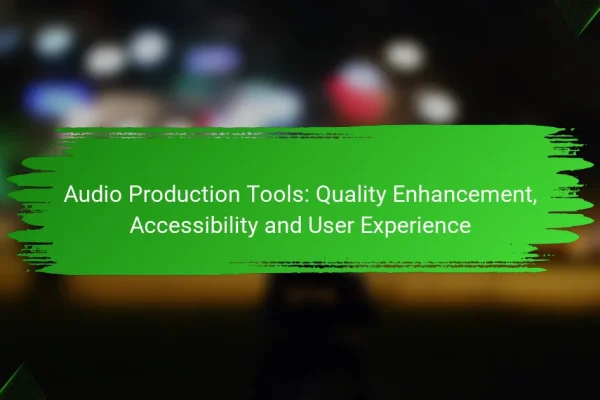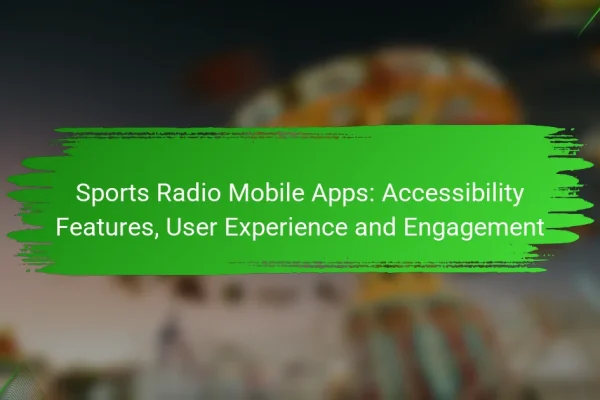
Sports Advertising Revenue: Seasonal Trends, Listener Behavior and Market Insights
In Australia, sports advertising revenue is shaped by distinct seasonal trends and listener behavior, prompting…
Sports radio broadcasting plays a vital role in delivering live sports coverage and engaging commentary to fans. In Australia, platforms like SEN Radio and ABC Radio Sport stand out for their unique features and audience interaction. Establishing a successful sports radio station requires careful planning, including licensing and equipment setup, while effective shows rely on engaging hosts and timely updates to captivate listeners.

In Australia, sports advertising revenue is shaped by distinct seasonal trends and listener behavior, prompting advertisers to strategically allocate their budgets around key sporting events. By analyzing audience preferences and habits, advertisers can effectively tailor their campaigns to enhance engagement and maximize impact, particularly as the market increasingly shifts towards digital platforms. What are the…

Innovative content formats are essential for capturing the attention of younger audiences in Australia, as they offer interactive and immersive experiences that align with their interests. By utilizing technology and creativity, brands can create shareable content that resonates deeply with this demographic. Current trends highlight the effectiveness of short-form videos, personalized content, and influencer collaborations…

Audio production tools play a crucial role in enhancing sound quality, accessibility, and user experience. With a range of industry-standard software available, both professionals and enthusiasts can achieve impressive audio results tailored to their skill levels and budgets. These tools not only streamline the creative process but also incorporate accessibility features, ensuring that all users,…

Themed segments are a powerful tool for attracting niche audiences in Australia, as they allow for the customization of content and marketing strategies to align with specific interests and demographics. By focusing on the unique needs and preferences of these groups, businesses can enhance engagement and foster community connections, ultimately leading to more effective attraction…

Listener preferences in sports content are shifting towards more personalized and interactive experiences, driven by technological advancements and changing demographics. As audiences increasingly demand tailored content that fits their lifestyles, traditional broadcasting methods are evolving to accommodate these new expectations. By leveraging data analytics and enhancing mobile accessibility, sports content providers can effectively meet the…

Sports radio mobile apps in Australia are designed to enhance accessibility and user experience, ensuring that all listeners, including those with disabilities, can enjoy their favorite sports content. With features like intuitive navigation, personalized content, and offline listening, these apps provide seamless access to real-time updates. Additionally, engagement strategies foster user interaction and loyalty, creating…

Polls and surveys are essential tools for enhancing listener engagement by allowing audiences to share their preferences and feedback. By fostering interaction, these methods create a stronger connection between listeners and content creators, ultimately leading to a more personalized experience. Various formats, such as multiple-choice and open-ended questions, can be employed to gather valuable insights,…

Sports radio podcasting is revolutionizing traditional broadcasting by providing on-demand content that meets the varied preferences of listeners. This evolution not only enhances audience engagement but also fosters loyalty by allowing fans to access discussions and analyses at their convenience. As mobile listening and targeted content become increasingly popular, podcasts are positioned to attract a…

The rise of streaming services is revolutionizing sports radio in Australia by enhancing accessibility and interactivity for listeners. With the ability to access live events and on-demand content anytime, fans are experiencing a shift in how they engage with their favorite sports, posing challenges for traditional radio to keep pace with evolving audience preferences. How…

Sports radio in Australia exhibits notable regional differences in popularity, shaped by factors such as local sports culture, team loyalty, and listener demographics. Metropolitan areas tend to enjoy higher engagement and a broader range of programming, while rural regions focus more on local teams and events. Understanding these trends is essential for grasping the dynamics…
The best sports radio broadcasting platforms in Australia include SEN Radio, ABC Radio Sport, Triple M, 2GB, and Radio 2UE. Each platform offers unique features, coverage, and audience engagement, making them popular choices among sports enthusiasts.
SEN Radio is a leading sports radio network in Australia, known for its comprehensive coverage of various sports, including AFL, NRL, and cricket. It provides live commentary, interviews, and expert analysis, catering to a passionate sports audience.
Listeners can tune in via FM, DAB+, or online streaming, ensuring accessibility across different devices. SEN Radio also engages its audience through social media platforms, enhancing interaction and community involvement.
ABC Radio Sport is part of the Australian Broadcasting Corporation and offers extensive sports coverage, including live broadcasts and updates on major events. It is recognized for its reliable reporting and in-depth analysis.
This platform is accessible through traditional radio frequencies and online streaming, making it easy for listeners to stay informed about their favorite sports. ABC Radio Sport also features expert commentators and regular segments that discuss current sports issues.
Triple M is well-known for its entertaining approach to sports broadcasting, combining music and sports commentary. It covers a variety of sports, with a strong focus on AFL and NRL, appealing to a broad audience.
Listeners can enjoy live games, humorous segments, and interviews with sports personalities. The platform is available on FM radio and through its app, allowing fans to engage with content on the go.
2GB is a popular talk radio station that includes sports programming as part of its lineup. It provides news, commentary, and live coverage of significant sporting events, particularly rugby league and cricket.
Listeners appreciate the station's engaging hosts and interactive segments, which encourage audience participation. 2GB can be accessed via AM radio and online streaming, making it a convenient option for sports fans.
Radio 2UE offers a mix of talk and sports content, featuring live broadcasts and discussions on various sports topics. It is known for its experienced presenters and comprehensive coverage of local and international events.
Listeners can tune in through AM frequencies and online platforms, ensuring they stay connected with the latest sports news and commentary. Radio 2UE also emphasizes listener engagement through call-ins and social media interactions.
Starting a sports radio broadcasting station involves several key steps, including obtaining licenses, setting up equipment, and choosing a suitable broadcasting platform. Each of these components is crucial for ensuring a successful launch and operation of your station.
To legally operate a sports radio broadcasting station, you must acquire the appropriate licenses. In the United States, this typically involves obtaining a license from the Federal Communications Commission (FCC), which regulates radio frequencies and broadcasting standards.
Additionally, consider copyright licenses for music and other content. Organizations like ASCAP and BMI manage these rights, and obtaining licenses from them is essential to avoid legal issues.
Setting up broadcasting equipment is a critical step in launching your sports radio station. You will need a good quality microphone, audio mixer, headphones, and broadcasting software. Depending on your budget, you can opt for entry-level equipment or invest in professional-grade tools.
Consider the layout of your studio space to ensure optimal sound quality. Soundproofing materials can help reduce external noise, enhancing the listening experience for your audience.
Selecting the right broadcasting platform is essential for reaching your audience effectively. Options include traditional FM/AM radio, online streaming services, or podcasting platforms. Each has its own advantages and limitations regarding reach, cost, and audience engagement.
For online broadcasting, platforms like Spreaker or Mixlr offer user-friendly interfaces and various features to enhance your broadcasts. Evaluate your target audience and choose a platform that aligns with their listening habits and preferences.
Successful sports radio shows combine engaging hosts, interactive audience segments, and timely sports updates to create a compelling listening experience. These elements work together to attract and retain listeners while providing valuable insights into the world of sports.
Engaging hosts are the backbone of any successful sports radio show. They should possess strong communication skills, a deep knowledge of sports, and the ability to connect with the audience on a personal level. Charismatic personalities can draw in listeners and keep them entertained throughout the broadcast.
Hosts should also be able to adapt their style to suit the show's format, whether it be serious analysis or light-hearted banter. Regularly featuring guest hosts or experts can also add variety and keep the content fresh.
Interactive audience segments are crucial for building a loyal listener base. Incorporating call-ins, social media interactions, and live polls allows listeners to engage directly with the show. This interaction not only enhances the listening experience but also fosters a sense of community among fans.
Consider dedicating specific segments to audience questions or comments, which can help tailor content to listener interests. Utilizing platforms like Twitter or Facebook can facilitate real-time engagement and feedback.
Timely sports updates are essential for keeping listeners informed about the latest developments in their favorite sports. Regularly scheduled updates, especially during peak times like game days, ensure that audiences receive crucial information as it happens. This could include scores, player injuries, and trade news.
To maintain relevance, hosts should stay updated on current events and trends in the sports world. Utilizing reliable sources and providing context around updates can enhance the quality of information shared with listeners.
Sports radio broadcasting offers diverse advertising opportunities that can effectively reach targeted audiences. These include local business sponsorships, national brand partnerships, and digital ad placements, each providing unique advantages for advertisers.
Local business sponsorships allow small to medium-sized enterprises to connect with their community through sports radio. By sponsoring segments or shows, businesses can enhance their visibility and build brand loyalty among local listeners.
Typically, these sponsorships involve on-air mentions, promotional events, or exclusive offers for listeners. For example, a local restaurant might sponsor a weekly sports talk show, providing discounts to listeners who mention the show.
National brand partnerships in sports radio broadcasting enable larger companies to reach a broader audience. These partnerships often include advertising campaigns that leverage popular sports events or high-profile shows to maximize exposure.
Brands may engage in co-branded promotions or exclusive sponsorships during major sporting events, such as the Super Bowl or the World Series. This strategy can significantly boost brand recognition and sales, especially when paired with compelling content that resonates with sports fans.
Digital ad placements in sports radio broadcasting have become increasingly important as audiences shift to online platforms. Advertisers can utilize targeted ads on streaming services, social media, and podcast platforms to reach specific demographics effectively.
These placements can take various forms, including banner ads, pre-roll audio spots, or sponsored content. Advertisers should consider the performance metrics of digital campaigns, such as click-through rates and audience engagement, to optimize their strategies and maximize return on investment.
Sports radio broadcasters encounter several challenges that can impact their effectiveness and reach. Key issues include competition from digital media, maintaining listener engagement, and adapting to changing regulations.
The rise of digital media platforms has significantly increased competition for sports radio broadcasters. Streaming services, podcasts, and social media provide alternative ways for audiences to consume sports content, often leading to fragmented listener bases.
To remain relevant, broadcasters must differentiate their offerings by providing unique insights, live commentary, or interactive segments that digital platforms may not offer. Engaging with audiences through social media can also help build a loyal listener community.
Keeping listeners engaged is crucial for sports radio broadcasters, especially in a landscape filled with numerous entertainment options. Broadcasters need to create compelling content that resonates with their audience, such as interviews with players, expert analysis, and live game coverage.
Regularly soliciting listener feedback and incorporating it into programming can enhance engagement. Additionally, using interactive elements like call-ins or social media polls can foster a sense of community and keep listeners returning for more.
Sports radio broadcasters must navigate a complex landscape of regulations that can vary by country and region. Issues such as licensing, advertising standards, and content restrictions can impact how broadcasts are produced and delivered.
Staying informed about local regulations is essential for compliance and avoiding penalties. Broadcasters should regularly review their practices and consult legal experts to ensure they adapt to any changes in the regulatory environment, particularly regarding advertising and sponsorship deals.
Sports radio broadcasting relies on various technologies to deliver live commentary and updates to listeners. Key technologies include traditional AM/FM radio, digital audio broadcasting (DAB), and internet streaming, each offering unique advantages and challenges.
Digital audio broadcasting (DAB) is a modern method of transmitting radio signals that provides improved sound quality and more channels compared to traditional analog broadcasting. DAB uses digital compression to transmit multiple audio streams within the same frequency band, allowing for a richer listening experience.
One of the main benefits of DAB is its ability to reduce interference and enhance audio clarity. Additionally, DAB receivers can display information such as song titles and artist names, which enhances user engagement. However, coverage can vary, and not all areas may have access to DAB signals.
When considering DAB for sports radio broadcasting, ensure compatibility with existing equipment and check local coverage maps. It's advisable to invest in a quality DAB receiver to fully benefit from the enhanced audio and additional features. Be aware of potential costs associated with upgrading equipment or subscriptions for premium content.